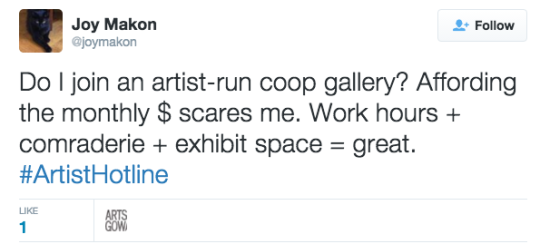Ask #ArtistHotline: Should I Join a Co-op Gallery?
The Pros and Cons of this Model for Exhibiting Work
Each #ArtistHotline, we receive a lot of questions from artists about co-op galleries:
- What is a co-op gallery?
- How do I apply to an artist cooperative?
- What are the membership benefits?
Before you even consider applying to a co-op gallery, learn as much as you can about it. Co-op galleries have positive attributes, like socializing with fellow artists and collaborating on group events. However, it is a significant time commitment and monthly investment. From membership fees to group exhibitions, you should review the membership criteria carefully.
To make the decision process easier we created a run-down of pros and cons. Review our list below and then determine if the model fits your individual needs as an artist.
What is an Artist Co-op?
According to Co-opLaw.org, an “artist cooperative provides benefits that are specific to its artists/artisan members, but can function similarly to other types of cooperatives, such as worker cooperatives, producer/marketing cooperatives, or purchasing cooperatives. Artist cooperatives are most commonly created for marketing purposes, which may include sharing retail or gallery space, marketing over the Internet, or publishing and distributing a catalog.”
There are numerous models of artist co-ops nationwide. For example, Regina Rex, is an artist-run gallery based in Brooklyn that is part of NYFA Fiscal Sponsorship. The space is collectively run by artists and curates several group exhibitions. Washington Printmakers Gallery is another membership based community in Washington D.C. This article will be focus on co-op galleries and explore the reasons why artists join specific communities. Let’s start with how to join a co-op gallery and delve deeper into the pros and cons.
How do I join a Co-op Gallery?
First, you have to apply to become a member. A co-op gallery is different than a commercial gallery because there is a financial obligation. Members typically pay an initial entry fee and monthly dues. Before joining a co-op gallery, you should carefully consider the investment. The amount of membership fees will vary depending on the venue and region you live in.
Each member is financially invested in the running of the gallery and shares in the decision-making. For example, members make major business decisions together, like insurance, rental payments and other financial matters. In some scenarios, individuals are assigned positions, such as treasurer, marketing manager or managing the gallery sitting schedule.
What do the monthly fees support?
Membership fees address expenses like gallery maintenance, special events, or online promotion. In some instances, if you sell your artwork, you may have to pay a commission fee. There are requirements for membership at every co-op. If you’re interested in joining the co-op gallery you’re required to fill out an application and share details about your artistic background. New co-op members are accepted as space becomes available; and there may be a jurying process to be a part of the co-op. At times, the premises may include artists’ studios, along with the gallery. Each co-op does business in a slightly different way and their membership guidelines will vary.
What questions should I ask myself before joining a co-op gallery?
If you decide to join a coop gallery, consider your needs as an artist and weigh the pros and cons carefully. Ask yourself the following questions:
- Can you afford the monthly cost?
- Do you have time for the work requirements?
- What art disciplines are represented in the co-op gallery? Do they match your style and aesthetic?
- Will the co-op gallery provide you with the exposure you need for the investment?
The underlining goal is to collectively foster community and create space to exhibit work. The conditions should benefit both the individual artist, as well as the co-op. Before submitting your membership application, review the co-op’s submission guidelines and make time to visit the venue. Then run down our quick list of pros & cons:
PROS
You will Learn How to Run A Gallery
Working at a co-op gallery teaches you the business side of growing a sustainable art business. As a cooperating owner, you’re involved with the daily business decisions and day-to-day gallery policies. Depending on the gallery, you may gallery sit, sell artwork and learn what happens behind the scenes. This experience, particularly for emerging artists, is valuable.
Co-op Galleries Offer Exhibition Space
The annual fees often guarantee group or juried shows for each member. Particularly, in regions with few art galleries or limited opportunities for representation, co-ops provide artists with an opportunity to exhibit work. However, publicity isn’t guaranteed. Like commercial galleries, it’s a risk to participate.
CONS
Monthly Fee
Co-op galleries pay expenses, like rent, using the financial resources of their members. You may pay $100 or more a month for your membership. Like any financial endeavor, do your research prior to joining a co-op and make sure you can afford the cost and that you have realistic expectations about your investment. Talk to fellow artists who have participated in co-op galleries and inquire about their experiences.
Time Commitments
Volunteering at the co-op gallery may leave little time for your studio practice. The time commitment can be a deterrent. In addition, some artists tend to shy away from the sale aspect that may be required.
Wide Range of Artist Background
Each co-op is run differently and has its own way of selecting artists. Depending on the gallery, you may be exhibiting with a wide range of artists, some less experienced than others. If you’re more established in your career, consider if you want to exhibit with emerging artists.
What has been your experience with co-op galleries? Send us your questions and comments using the hashtag #ArtistHotline on Twitter.
Make sure to follow @nyfacurrent and join our Artist Professional Development Day, the third Wednesday of every month.
– Glory Edim, Program Associate, Online Resources
Inspired by the NYFA Source Hotline, #ArtistHotline is a new initiative dedicated to creating an ongoing online conversation around the professional side of artistic practice. Our goal is to help artists discover the resources needed, online and off, to develop sustainable careers.





